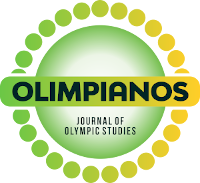Exploring gender equity in Olympic and Paralympic governance: challenges and perspectives
DOI:
https://doi.org/10.30937/2526-6314.v8.id190Keywords:
gender equality, gender balance, Olympic values, leadership, national contextAbstract
Gender balance remains a fundamental concern in the evolution of the Olympic movement. Major issues such as equitable participation of male and female athletes and parity within its leadership are at the forefront of discussions. Scholars have shown gender imbalance in sports governance, with men holding a disproportionate share of power compared to women. This study examines the composition of the governing bodies of national Olympic and Paralympic committees. It aims to understand how gender equality representation in national bodies is compounded by the traditions of the sport associated with men, maintaining the gender gap in leadership. The findings highlight persistent disparities in gender representation in the governance structures of Olympic and Paralympic committees, despite variations among countries. These differences underscore the varying gender equality standards among participating nations, necessitating targeted interventions to address underlying societal inequalities. This article seeks to enhance understanding of the multiple factors shaping gender equality in the Olympic domain by providing insight into the dynamics surrounding gender balance at the Olympic and Paralympic Games. The results of these analyses could inform future initiatives aimed at promoting diversity and inclusion within the Olympic movement.
Downloads
References
Anderson JHE. Sport, gender and sexuality - Surveying the field. In: Jennifer Hargreaves EA, editor. Routledge Handbook of Sport, Gender and Sexuality. London: Routledge; 2014. p. 3-18.
Sartore ML, Cunningham GB. Explaining the under-representation of women in leadership positions of sport organizations: A symbolic interactionist perspective. Quest. 2007;59(2):244-65.
Claringbould I, Knoppers A. Finding a ‘normal’ woman: Selection processes for board membership. Sex Roles. 2007;56(7):495-507.
Ogilvie M, McCormack M. Gender-collaborative training in elite university sport: Challenging gender essentialism through integrated training in gender-segregated sports. International Review for the Sociology of Sport. 2021;56(8):1172-88.
Mateo-Orcajada A, Abenza-Cano L, Vaquero-Cristóbal R, Martínez-Castro SM, Leiva-Arcas A, Gallardo-Guerrero AM, et al. Influence of gender stereotypes, type of sport watched and close environment on adolescent sport practice according to gender. Sustainability. 2021;13(21):11863.
Burton LJ. Underrepresentation of women in sport leadership: A review of research. Sport Management Review. 2015;18(2):155-65.
Sotiriadou P, de Haan D. Women and leadership: advancing gender equity policies in sport leadership through sport governance. International Journal of Sport Policy and Politics. 2019;11(3):365-83.
Piggott LV, Pike EC. ‘CEO equals man’: Gender and informal organisational practices in English sport governance. International Review for the Sociology of Sport. 2020;55(7):1009-25.
Evans AB, Pfister GU. Women in sports leadership: A systematic narrative review. International Review for the Sociology of Sport. 2021;56(3):317-42.
Ahn GBCNY. The role of bias in the under-representation of women in leadership positions. In: Nancy Lough ANG, editor. Routledge Handbook of the Business of Women's Sport. London: Routledge; 2019. p. 83-94.
Knoppers A, Spaaij R, Claringbould I. Discursive resistance to gender diversity in sport governance: sport as a unique field? International Journal of Sport Policy and Politics. 2021;13(3):517-29.
Committee IO. Gender equality & inclusion International Olympic Committee report 2021. International Olympic Committee; 2021.
Committee IO. Gender equality and Inclusion International Olympic Committee objectives 2021-2024. International Olympic Committee; 2022.
Dean NA, Bundon A, Howe PD, Abele N. Gender Parity, False Starts, and Promising Practices in the Paralympic Movement. Sociology of Sport Journal. 2022;39(3):221-30.
Ferez S, Ruffié S, Joncheray H, Marcellini A, Pappous S, Richard R. Inclusion through Sport: A critical view on Paralympic legacy from a historical perspective. 2020. 2020;8(3):12.
Esteban Salvador ML, Güngör Göksu G, Fernandes E, Di Cimbrini T, & Jones R. Analysis of gender equality policies on the boards of directors of national sports federations: An exploratory analysis: survey report (No. BOOK-2022-026). Servicio de Publicaciones Universidad de Zaragoza; 2002.
Ryan I, Dickson G. The invisible norm: An exploration of the intersections of sport, gender and leadership. Leadership. 2018;14(3):329-46.
LaVoi LJBNM. An ecological/multisystem approach to understanding and examining women coaches. In: LaVoi NM, editor. Women in Sports Coaching. London: Routledge; 2016. p. 49-62.
Eagly AH, Carli Linda L. Women and the labyrinth of leadership. In: William E. Rosenbach RLT, Mark A. Youndt, editor. Contemporary issues in leadership. New York: Routledge; 2018. p. 147–62.
Kane MJ. A socio-cultural examination of a lack of women coaches in sport leadership positions. In: LaVoi NM, editor. Women in Sports Coaching. London: Routledge; 2016. p. 35-48.
News media still pressing the mute button on women’s sports. University of South Carolina; 2012.
Bayle E. La gouvernance des fédérations d’associations chargées d’une mission de service public: le cas des fédérations sportives françaises Politiques et management public. 2010;27(1):22.
Cunningham GB. The Glass Cliff, gender, and sport leadership: A narrative review and meta-analysis. In: Norman L, editor. Improving Gender Equity in Sports Coaching. New York: Routledge; 2021. p. 11-29.
Downloads
Published
Issue
Section
License
Copyright (c) 2024 Olimpianos - Journal of Olympic Studies

This work is licensed under a Creative Commons Attribution-NonCommercial-ShareAlike 4.0 International License.
The authors authorize others to copy and redistribute the material in any medium or format. Remix, transform, and create from the material. You may not use the material for commercial purposes.






